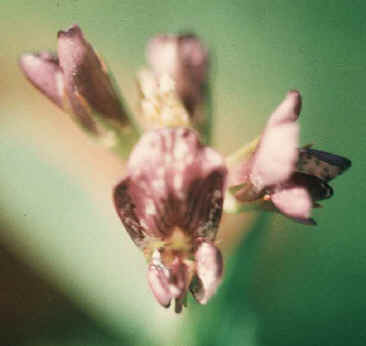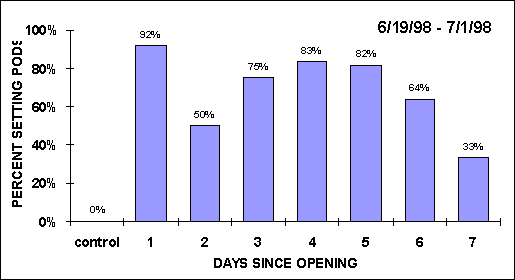![]()
Pollinator Paradise Parma R & E Center
PSES
College of Agriculture
University of Idaho
Research slide shows
Bee management
Philosophy
Links
Contact us
![]()
 Thrips damage; photo by Karen Strickler |
THRIPS DAMAGE
|
| Summary
of 1997 results
Methods of monitoring for thrips in alfalfa seed
|
We have been trying to determine some of the factors that cause blossom drop in alfalfa, and to assess whether thrips may contribute to blossom drop. Since little is known about thrips on alfalfa, one of our first tasks has been to determine how best to measure thrips populations, so we can document high populations, and compare fields. Insufficient pollination may be the most important cause of blossom drop, since untripped flowers remain open for only a week before wilting and falling off the raceme. This past summer weather played an important role in causing blossom drop. Cool spring weather delayed release of bees, and prevented bees from flying after they were released. The hot spell (90oF or above for 52 days in July and August, 100oF or above for 16 days in Parma), may have caused flowers and curls to drop, as well as reducing seed set in pods that did develop. Temperatures above 90oF are known to prevent seed set in tripped flowers, and may cause pods to abort. Last year Karen and Cody Cleaver found that the probability of setting seed declines rapidly for untripped flowers that have been open for more than 3 days (Dec., 1997 IASC Newsletter). Older flowers wilt before they are pollinated, but if they do not wilt they are likely to set seed. These results were from early in the season when temperatures were moderate (6/23-6/30, average high 83oF) and thrips populations were low in our research fields. Later in the season (7/3-7/9, average high 90oF) when thrips populations were high, flowers rarely lasted more than a day before wilting. Few of those flowers developed a curl after tripping. This year we again tested individual flowers to see how long they would last. Between June 19 and July 1, racemes that were about to bloom on 12 plants were marked with colored thread. When a flower opened on one of these racemes, all other buds were removed. On each plant, one flower was immediately tripped, one tripped after one day, one each after 2-7 days, and one not at all. Few bees were active in the field at this time due to cool, cloudy weather (mean high 78.5oF) so we did not bag the flowers. A few flowers were tripped by bees; these flowers were eliminated from the experiment. We recorded flowers that had wilted before they were ready to be tripped. We also recorded whether or not tripped flowers developed a pod. Flowers remained open in the cool weather much longer than they had last year at the same time (Fig. 1). Most of them did not wilt until the 6th or 7th day. (Day 2 appears to be an anomaly.) This is good news; it means that flowers will remain open and viable longer during cold spells than during hot spells. If temperatures warm up enough for bee activity, there is a reasonable chance that old flowers will be successfully pollinated. |
 |
| Summary
of 1997 results
Methods of monitoring for thrips in alfalfa seed
|
Methods of monitoring for thrips in alfalfa seed Regarding thrips, we monitored our research fields weekly using three different methods to see which was most effective in measuring thrips populations, and whether different methods give similar results. We counted thrips in standard 180o, sweep samples. We also counted numbers of thrips per flower in a sample of 25 flowers, calculating the average number of thrips per flower. Finally, once a week we placed a yellow sticky board in each field for about 7 hours, then counted the number of thrips that stuck to the board. We found that all three methods gave consistently low thrips numbers early in the season, and generally increasing numbers as time went on (Figs. 2-4). All three methods also detected a decline in thrips numbers in two of the fields after an application of MSR on July 17. Only the thrips per flower declined after a Dibrom treatment on Aug. 10, but not by much. The three sampling methods differed quite a bit in relative ranking of fields on different days. For example, on July 15, field "H" reached a higher peak in number of thrips per sweep and number of thrips per flower than the other fields. However, field "I" had the highest number of thrips per sticky board. Field I was close to field H in thrips per flower but was close to field "L" in thrips per sweep. |
(Click on any image below to see a larger version)
| Fig. 2
|
Fig. 3
|
| Fig. 4
|
Fig. 5
|
| Summary
of 1997 results
Methods of monitoring for thrips in alfalfa seed
|
Of the three sampling methods, sticky boards were the least desirable and accurate. Wind and rain affected the numbers of thrips that blew on to the boards. Other species of thrips and other small insects were often found on the boards, and required careful examination under a microscope; not a user-friendly technique. Thrips per flower was weakly correlated with thrips per sweep (Fig. 5), but high numbers of thrips per flower were associated with a wide range of thrips per sweep. There is probably an upper limit to the numbers of thrips that can fit in a flower, even when the thrips population is increasing. For these reasons we think that sweep samples are the best, most thorough sampling method that we have. They have the added advantage that most growers and field reps already sweep alfalfa seed fields for lygus, etc. We can’t come up with an economic threshold for thrips – a number of thrips per sweep high enough to cause more damage than the cost of chemical control – because we don't know what effect thrips have on seed yield. MSR is registered for thrips control on alfalfa. Our observation show a temporary decline in thrips populations with MSR. Your usual pest control measures for lygus bugs may impact thrips populations; the best way to tell is to count the thrips in sweep samples before and after you spray. More important, cultural practices should help keep down thrips populations. Clipping alfalfa in the spring can knock down the first generation of thrips, and prevent them from reaching damaging levels during pollination. A 1923 report recommends monitoring alfalfa after it is six inches high. "Thrips will be found to increase in numbers after they first appear, and then to suddenly drop off until there are only a very few …then the alfalfa should be cut as low as possible"(Seamans, 1923. Can. Entomol. 55:101-105). During hot spells and peak pollination, be sure the plants are not overly stressed for water, since water stress exacerbates thrips damage and is associated with increased thrips populations. Keep pollinator numbers high so flowers do not remain untripped long, especially when temperatures are hot. Also, try to preserve the minute pirate bug populations in your fields, since they are good predators of thrip eggs. |
![]()
Top of page Pollinator Paradise
Parma R & E Center
PSES College of Agriculture
University of Idaho
Research slide shows
Bee management
Philosophy
Links
Contact us
![]()
Revised Aug. 6, 2000.
Copyright © 2000,
Karen Strickler. All rights reserved.